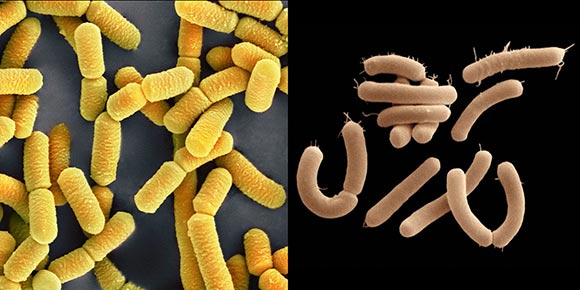Describe Some Medicinal Uses of Microorganisms With Examples
There is a mighty but invisible kingdom of microbes present within your body. Fungi such as yeast are used in the baking industries and also in the beer and wine industries.
Another important role in pharmaceuticals is the use of microbes for the medically important studies such as Bacteriorhodopsin figure 2 - adapted from Lehninger Principles of Biochemistry 5th edition a protein from the plasma membrane of Halobacterium salinarum.

. In laboratory experiments transferring bacteria from certain obese mice to normal ones led to increased fat in the normal mice. The others are used in making antibiotics like penicillin. They help the body to digest food.
Yeasts moulds mushrooms are some of the important fungi. GM microbes plants and animals also revolutionized the production of complex pharmaceuticals by enabling the generation of safer and cheaper vaccines and therapeutics. Penicillin Amoxicillin Tetracycline and.
The types of microorganisms that carry out food fermentations range from bacteria to molds and yeasts but by far the most widely used organisms are lactic acid bacteria LAB and yeasts Sacchromyces cerevisiae. Learn more about each of these five main categories as well as a. They support many forms of life both plant and animal and they are used in industrial and medicinal processes.
Microscopic organisms help in evolution which helps in making diverse types of dairy. Final outcomes from the most comprehensive analysis to-date of humans and their microbiomes definitively link microbes and microbial activities with health problems. Archaea Bacteria and Eukarya.
Small yet incredibly powerful these. Bacitracin is an antibiotic produced from Bacillus subtilis bacteria that is often used as a topical treatment. There they provide food for other living things.
Viruses and bacteria are probably the most familiar because we hear so much about them. Microbes in us and their role in human health and disease. Describe prokaryotic and eukaryotic morphology the two types of cellular anatomy and also the distribution of microorganisms among the various kingdoms or domains in which living organisms are categorized 6.
Microorganisms are used to make vitamins including C B 2 B 12. Bt-toxin gene is genetically engineered into crops to increase their yield. Bacitracin is a nonribosomal peptide synthetase that can create peptides that are generated in nature.
Yeasts are fungi that react with sugars to cause fermentation. Describe some of the various activities of microorganisms that are beneficial to humans 5. And of course microbes are essential to making many foods we enjoy such as bread cheese and wine.
But fungi protozoa and helminths are also big players in the story of infectious disease. Bacitracin for example is an antibiotic that is classed as a secondary metabolite. Other good bacteria can produce oxygen are used to create antibiotics.
For example each human body hosts 10 microorganisms for every human cell and these microbes contribute to digestion produce vitamin K promote development of the immune system and detoxify harmful chemicals. The azole and morpholine fungicides interfere with the synthesis of membrane sterols. Some helpful bacteria live inside human intestines.
Some bacteria are harmful but most serve a useful purpose. A few examples include the use of the bacterium Lactobacillus acidophilus to produce yogurt the exploitation of a number of different bacteria to produce a variety of cheeses and the fermentation of cabbage to produce sauerkraut. Nonetheless it is employed as an antibiotic in the clinic.
Other medicines produced include clotting factors to treat haemophilia 20 human growth hormone to treat various forms of dwarfism 21 22 interferon to treat some cancers erythropoietin for anemic patients and tissue plasminogen activator which dissolves blood clots. They decompose dead plants and animals extracting nutrients from them. In this chapter we will focus on the domains.
Some antifungal medications target the chitin cell walls of fungi. The microorganisms or microbes that can cause disease come in different forms. Traditional genetic modification methods that have been employedparticularly for microbial starter culturesinclude selection mutagenesis.
Antibiotics With only a few exceptions microorganisms are used to make antibiotics. The mix of microbes in your gut can affect how well you use and store energy from food. Other bacteria live on decaying things and help them rot turning them into nutrients which return to the soil.
Identify and describe symbiotic relationships. Types of Streptococcus are added to the batter before making bread to make the required flour. Creation of Dairy Items.
Compare normalcommensalresident microbiota to transient microbiota. The first medicinal use of GM bacteria was to produce the protein insulin to treat diabetes. Microbes are the key players here.
Identify and describe unique examples of prokaryotes in various habitats on earth. Blaser and his colleagues are concerned that changes in our microbiome early in life may contribute to weight problems later. These are used widely in agriculture fenpropimorph and clinically eg miconazole.
This helps make bread and pastries. Another example of benefits of microorganism in agriculture is their use as biological pest control for example Bacillus thuringiensis produce Bt-toxin which is lethal for insects if ingested but non-pathogenic to humans and other animals. These bacteria help to break down food and keep you healthy.
Pharmaceutical products range from recombinant hepatitis B vaccine produced by GM bakers yeast to injectable insulin for diabetics produced in GM Escherichia coli bacteria and to factor VIII for. Few fungi are harmful and cause fungal infections like ringworm. All living organisms are classified into three domains of life.

Microorganisms And Its Uses Various Uses With Videos Solved Examples



No comments for "Describe Some Medicinal Uses of Microorganisms With Examples"
Post a Comment